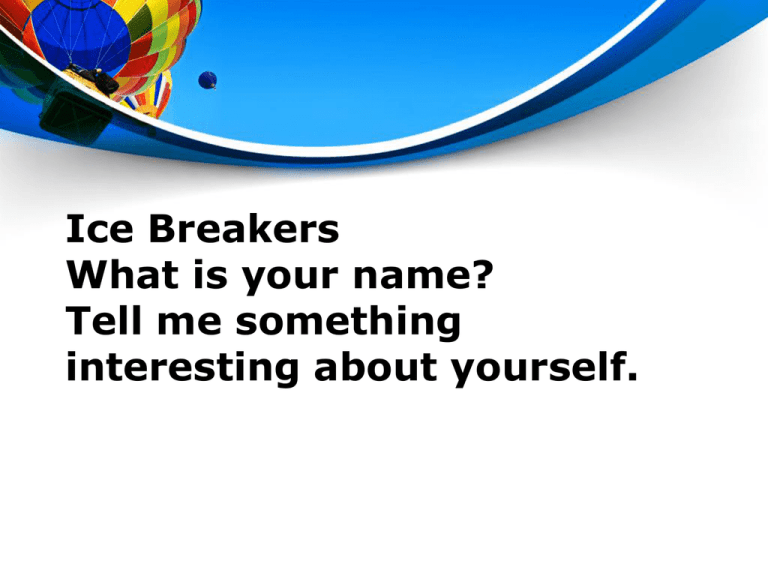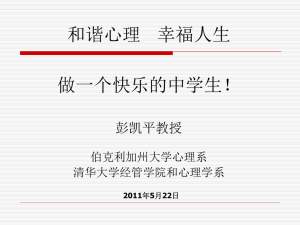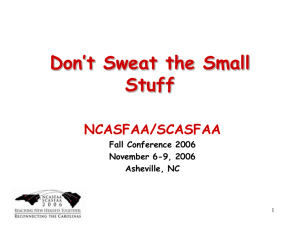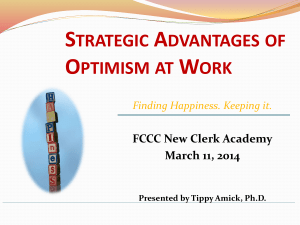Using Positive Psychology to Enhance Student Success
advertisement

Ice Breakers What is your name? Tell me something interesting about yourself. Using Positive Psychology to Enhance Student Success Dr. Marsha Fralick PowerPoint and Handouts posted online at: http://www.collegesuccess1.com/spc.html See Handout How does it relate to student success? What is positive psychology? Highlights from: A Primer in Positive Psychology by Christopher Peterson Positive psychology is the scientific study of what goes right in life. Named by Martin Seligman, president of the American Psychological Association, 1998 Focus Psychology Positive Psychology • Focus on weakness • Relieving distress • Curing illness • Focus on strengths • Building the best in life • Fulfillment Basic Ideas People matter. Money cannot buy happiness. Components of Positive Psychology • Positive subjective experiences: happiness, pleasure, gratification, fulfillment • Positive individual traits: strengths of character, talents, interests, values • Positive institutions: families, schools, business, communities, societies Love and happiness is not reserved for the lucky or the strong. It can be attained by hard work and may entail careful deliberation and awkward action. Positive Emotions Enhance Learning • Better attention • Memory improvement • Greater verbal fluency • Increased openness to information Negative Emotions • Signal danger • Focus on the here and now to find safety Positive emotions help to plan the future. Positive Psychology and Teaching Fear is the root of academic failure. It inhibits new learning and blocks intrinsic motivation. Positive Psychology and Teaching • Move from avoiding failure to expecting success. • Help students feel emotionally safe. • Encourage positive selfnarrative. Examples: Using Psychology in Teaching • Setting the tone. • Start class on a positive note. • Responding to students. • Providing feedback on assignments. • Build on strengths. • Build interest. Happiness A field within positive psychology Highlights from Authentic Happiness by Martin Seligman Happiness is . . . Think Pair Share Besides friends and family, happiness is . . . . Many students confuse hedonism with happiness. Hedonism Vs. Happiness Hedonism Happiness • Maximizing pleasure and minimizing pain • Immediate gratification • Identifying one’s values and acting on them • Self-actualization Maybe life involves a little of both, but not hedonism only. Hedonist Adaptation We assume that more material possessions will make us happy, but the more material possessions, the greater the expectations, and we no longer appreciate what we have. Hedonism is a shortcut to happiness that leaves us feeling empty. Real happiness comes from identifying, cultivating and using your personal strengths in work, love, play and parenting. -Martin Seligman Being in the Flow • Related to happiness • Sports: “Being in the zone” • The psychological state that accompanies highly engaging activities • Engagement! Being in the flow • Most likely to occur when there is optimal balance between skill and challenge • These activities leave us invigorated and satisfied • Result in positive emotions Formula for Happiness Happiness = S + C + V S: Set Range:50% determined by heredity C:Circumstances: about 10% of happiness V: Voluntary Control: 40% of happiness 3 Good Things Think Pair Share What are 3 good things that happened last week? Suggestions for Improving Happiness Realize that the past does not determine your future. The future is open to new possibilities. Be grateful for the good events of the past and place less emphasis on the bad events. Build positive emotions through forgiving and forgetting. Work on increasing optimism and hope for the future. Find activities that make you happy and engage in them. Take the time to savor the happy times. Make mental photographs of happy times so you can think of them later. Take time to enjoy the present moment. Build more flow into your life. Express gratitude. Avoid over-thinking and social comparison. Practice acts of kindness. Commit to accomplishing your goals. Maintain a healthy lifestyle. Take care of your body. Improving Retention and Success Making the Most of the First Week of Your Course The first week sets the stage for all that follows. Start with Engagement Do an engaging and enjoyable activity so that students leave the first class with enthusiasm for the course. The Snowball Activity Pace Your Class • Spend no more than 10-15 minutes on any one activity. • Plan activities that require student interaction. • Move them out of their seats. Student Engagement Effective Groups: Preview the Topic Supportive Learning Environment Positive feedback: Examples I believe that students learn better in a positive and supportive environment. It is my goal to be supportive of your learning and encourage you to be supportive and respectful of other students. Introduce Yourself • Your educational journey • Your most important values • Why you enjoy teaching this course • What you hope students learn in the course • Your professional experience • Your favorite inspirational quote Keep it short! Introductions Get to know your students and help students get to know one another. The Syllabus Don’t read your syllabus to the class! What are some interesting ways to present your syllabus? Think, Pair, Share Behavior Set the standards for appropriate behavior and enforce them from the first day. Improving Attendance Free writing The Critical Period: The first 2 weeks • Attendance • Engagement • Completion of the first assignment • Follow-up for those who have not completed it Flipping Your Classroom to Improve Student Success and Engagement What is a flipped classroom? It involves rearranging the typical events in a classroom. Key Idea: Read the assignments before the class begins. Verify that the reading has been done. Benefits for Students • More actively engaged in learning • Assume more responsibility for their learning • More opportunity for practice and learning from others • Get in the habit of pre-reading textbooks which is critical in more challenging courses Benefits for Faculty • Change roles from lecturer to coach or guide • Freed from repetitive classroom lectures • Additional time for collaborative learning and social interaction What did you like? What can you use next semester? Think, Pair, Share








